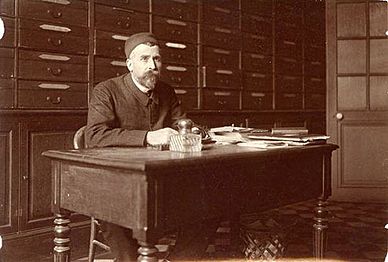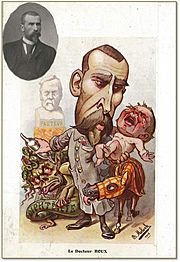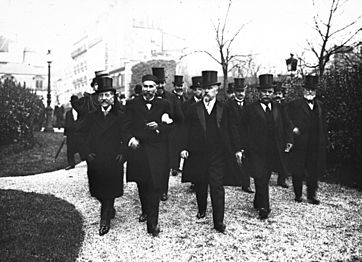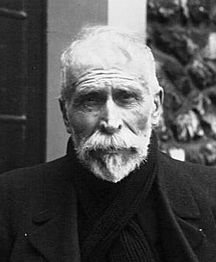Émile Roux facts for kids
Quick facts for kids
Émile Roux
|
|
|---|---|
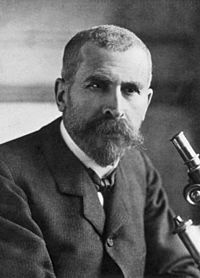
Roux (c. 1900)
|
|
| Born | 17 December 1853 |
| Died | 3 November 1933 (aged 79) Paris, France
|
| Nationality | French |
| Known for | Pasteur Institute anti-diphtheria serum |
| Awards | Copley Medal (1917) |
| Scientific career | |
| Fields | Physiology, bacteriology, immunology |
| Influences | Louis Pasteur Émile Duclaux |
Pierre Paul Émile Roux (17 December 1853 – 3 November 1933) was an important French physician, bacteriologist, and immunologist. A bacteriologist studies tiny living things called bacteria. An immunologist studies how our bodies fight off diseases.
Roux was a close helper of Louis Pasteur, a famous scientist. He also helped start the Pasteur Institute in Paris. Roux was key in making the first effective treatment for diphtheria, a serious disease. This treatment was called an anti-diphtheria serum. He also studied diseases like cholera, chicken-cholera, rabies, and tuberculosis. Many people see Émile Roux as a founder of the field of immunology.
Contents
Early Life and Studies
Émile Roux was born in Confolens, France, in 1853. He finished high school in 1871. In 1872, he began studying medicine at the Medical School of Clermont-Ferrand. He first worked as a student helper in chemistry with Émile Duclaux.
From 1874 to 1878, Roux continued his studies in Paris. He became a clinical assistant at Hôtel-Dieu, a hospital. In 1878, he started helping Duclaux teach about fermentation at the Sorbonne University.
Working with Louis Pasteur
Émile Duclaux suggested Roux to Louis Pasteur, who needed assistants. Roux joined Pasteur's lab in 1878 and worked there until 1883. He started by helping with animal injections. He was very good at these tasks and soon became more involved in research.
Roux began studying how tiny microbes cause diseases. He worked with Pasteur on avian cholera (a disease in chickens) and anthrax (a serious disease affecting animals and humans). He was part of a famous experiment on anthrax vaccination at Pouilly-le-Fort. In this test, Pasteur and Roux gave their anthrax vaccine to 25 sheep. Another 25 sheep did not get the vaccine. Then, all 50 sheep were given the anthrax bacteria. As predicted, all 25 vaccinated sheep lived, and all 25 unvaccinated sheep died.
Louis Pasteur and Émile Roux sometimes had different ideas about how to study diseases. Pasteur liked to do experiments in the lab. Roux was more interested in treating patients. They often disagreed while working on vaccines for anthrax and rabies. One main issue was how much animal testing was needed before giving a vaccine to humans. Roux was more careful and wanted more proof that the rabies vaccine was safe for animals before using it on people.
In 1883, Roux earned his medical degree. His paper was about his research on rabies with Pasteur. This work led to the first vaccine against this scary disease. Roux found out that rabies could spread through the brain. This discovery helped Pasteur's research a lot. Roux became known as an expert in the new fields of medical microbiology and immunology.
In 1883, Roux traveled to Egypt with other assistants to study a human cholera outbreak. They could not find the cause of the disease there. Later, the German doctor Robert Koch found the pathogen (the germ that causes the disease) in Alexandria.
For the next 40 years, Émile Roux was deeply involved in creating the Pasteur Institute. He helped develop the idea of combining research, development, and patient care in one special hospital. The Pasteur Hospital was known for giving free medical care. It was also very clean for its time. In 1888, Roux became the Director of Services at the Institute. He also started the first regular course on how to study microbes. This course helped train many important French and foreign doctors and researchers in infectious diseases.
Diphtheria Research
Developing a treatment for diphtheria was a race between researchers. Emil von Behring in Berlin and Émile Roux in Paris both worked on it. They both created an anti-toxin serum around the same time.
Diphtheria is a contagious disease that causes throat problems, nerve damage, and heart issues. Roux and Alexandre Yersin published their first important work on diphtheria in 1883. They showed that a germ called the Klebs-Loeffler bacillus caused the disease. Diphtheria was very common and deadly, especially for children.
Roux studied the toxin (poison) made by the diphtheria germ. In 1891, he began to develop an effective serum to treat the disease. This was after Emil Adolf von Behring and Kitasato Shibasaburō showed that animals could make antibodies against the diphtheria toxin.
Roux successfully showed how to use this antitoxin. He worked with Auguste Chaillou in a study with 300 sick children at the Hôpital des Enfants-Malades (Children's Hospital). After this, he was celebrated as a science hero at medical meetings across Europe.
The first Nobel Prize for Physiology and Medicine was given to Emil Von Behring for his work on diphtheria serum therapy. Roux had been nominated in 1888 for finding the diphtheria toxin. But he did not win the prize in 1901 because his discovery was considered too "old." Roux was nominated for the Nobel Prize many times but never won.
Later Years and Achievements
In 1904, Émile Roux became the General Director of the Pasteur Institute, taking over Pasteur's former position. He was elected a member of the Royal Swedish Academy of Sciences in 1900.
In 1916, he moved into a small apartment at the Pasteur Hospital. He passed away there on 3 November 1933.
Awards and Honors
- In 1917, he received the Copley Medal for his amazing achievements in research.
- An Asteroid named 293366 Roux was discovered in 2007. It was named in his honor.
- The Roux culture bottle, a special container used for growing cells, is named after him.
Gallery
-
An injection against croup at the Hôpital Trousseau in Paris, with Roux observing, by P.A.A. Brouillet in 1893
-
Dr. Emile Roux, Albert Edelfelt, 1896
See also
 In Spanish: Émile Roux para niños
In Spanish: Émile Roux para niños




